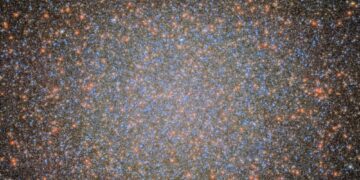Globular clusters are more than just dazzling sights in the night sky—they’re cosmic fossils. Astronomers have long known these star-packed spheres contain some of the oldest stars in the universe, but until now, determining their exact ages has remained elusive. In a groundbreaking study led by Jiaqi (Martin) Ying from Dartmouth College, scientists have finally pinpointed the absolute ages of eight Milky Way globular clusters (GCs). This achievement helps us better understand not only our galaxy’s formation but also the timeline of cosmic evolution itself.
The Science of Stellar Age: How Do You Date a Star Cluster?
Determining the age of stars isn’t as simple as checking their birth certificates—but scientists have developed reliable tools. In this study, researchers utilized photometric data from the Hubble Space Telescope’s Advanced Camera for Surveys, part of a globular cluster survey program. They compared this data to isochrones—curves on a Hertzsprung-Russell diagram that trace the brightness and color of stars of the same age.
Isochrone fitting works particularly well with GCs because their stars are thought to be coeval, forming in the same era. By plotting a range of stellar brightness and temperature data against theoretical models, scientists can estimate the absolute age of a cluster with much-improved precision.
Unprecedented Accuracy: What the Study Discovered
This research analyzed eight globular clusters: 47 Tuc (NGC 104), NGC 4147, NGC 5053, NGC 5466, NGC 6362, M55 (NGC 6809), M15 (NGC 7078), and M30 (NGC 7099). The team determined that these clusters range in age from approximately 11.5 to 13.5 billion years, making them nearly as old as the universe itself.
In a particularly striking finding, the researchers identified two separate populations within the 47 Tuc cluster. Population 1 is about 11.91 billion years old, while Population 2 is slightly older at 12.02 billion years. This challenges the long-standing assumption that all stars in a globular cluster form simultaneously.
Implications for Cosmic History: The Age-Metallicity Connection
Beyond age, the team also mapped the metallicity—how many elements heavier than helium are present in these stars. They established the first absolute age-metallicity relation for Milky Way GCs. Older clusters were shown to have lower metallicity, reinforcing the prevailing theory that the universe began with fewer heavy elements and became enriched over time through stellar processes.
This discovery supports models of hierarchical galaxy formation, suggesting that the Milky Way assembled over billions of years by absorbing smaller, metal-poor satellite galaxies. These ancient GCs are, in a very real sense, the stellar immigrants of our galactic halo.
Tackling the Big Unknowns: What Makes Age Estimates Tricky
While the results are groundbreaking, they’re not without uncertainty. The researchers found that the greatest sources of error stemmed from measuring distance and interstellar reddening—how dust and gas obscure and shift the light from distant stars. These factors contribute over 50% of the total uncertainty in age estimates.
Previous efforts to gauge GC distances were hampered by limited data, but thanks to ESA’s Gaia mission, astronomers now have more accurate parallax measurements for many Milky Way objects. Yet, many GCs sit in the galaxy’s outer halo where Gaia’s data becomes sparse, leaving room for future improvements.
Multiple Populations, Minimal Impact: Debunking a Major Concern
There has been some concern that the presence of multiple stellar populations in GCs would skew absolute age results. However, this study found their influence to be limited. For instance, despite 47 Tuc containing distinct populations, its age estimate still fell within the expected uncertainty margin.
This finding reassures astronomers that even in complex clusters, current age-dating techniques remain robust. That’s a big win for anyone building cosmic timelines or simulating the evolution of galactic structures.
Why It All Matters: Building a Better Cosmic Clock
Understanding the absolute age of GCs is essential to constructing a detailed timeline of the universe. These ancient stars offer a lower boundary for the age of the Milky Way and serve as anchor points for models of star and galaxy formation. By aligning observational data with theoretical models, we can now refine the story of how the cosmos went from a sea of hydrogen to a complex tapestry of stars, planets, and galaxies.
This research also strengthens the scientific foundation for future studies on dark matter distribution, star cluster mergers, and chemical evolution within galaxies. In short, it’s more than just stellar archaeology—it’s the scaffolding of modern astrophysics.
The Road Ahead: What’s Next for Globular Cluster Science?
This study is a significant leap forward, but it also opens new doors. As telescopes like the James Webb Space Telescope (JWST) and next-gen observatories like the Nancy Grace Roman Space Telescope come online, astronomers will gain sharper views and deeper insights into distant clusters. Improved modeling tools and more precise data could narrow down uncertainties even further.
Moreover, extending these age-dating techniques to clusters in other galaxies could help us understand whether the Milky Way’s history is typical—or unique—in the cosmic landscape.
Conclusion: Ancient Stars, Timeless Insights
Globular clusters aren’t just pretty celestial ornaments. They’re historical records, cosmological keys, and stellar laboratories. Thanks to the dedicated work of researchers like Ying and colleagues, we now have a clearer, more accurate view of when these clusters formed and what they can teach us about the broader universe.



















